| |
"Whither goest thou, America, in thy shiny car in the night?" |
| |
Jack Kerouac, 'On the Roadi |
| |
The ideal situation for me is working on a film like Two-Lane Blacktop where there are so many unconscious things happening in the creation of it that even after finishing the editing and mixing, and the making of the final print, I can go to see the film and still find new things in it. That to me is a stimulating experience. |
| |
Interview with Director, Monte Hellman *
|
That is, of course, the very definition of the sometimes beautiful but always interesting wake that flows out from behind the successful result of a creative process. Unconscious things start happening. It's the essence of marshalling your craft and seeing what becomes of your creation. It's a unique chemistry that all good artists take advantage of. You make a choice and the tumblers fall, tumblers that would have stayed locked had your idea not freed them. Two-Lane Blacktop is a very unusual American movie. It has longeurs – held shots in which very little actually happens. These were much more European in style at the time of production. It is unashamedly artistic rather than commercial (it's not surprising it made no money on release) and it has a heavy cloak of quiet yearning draped all over it. I'm trying not to grasp at pretension here (despite, perhaps, reluctantly succeeding). It's just that every now and again along comes a movie that offers in every shot an invitation to the audience (observe and feel...) rather than an assault (WATCH and WINCE!). Its characters are deftly sketched and given depth with very little effort and if you're prepared to go halfway, the small but potent delights of the film are considerable.
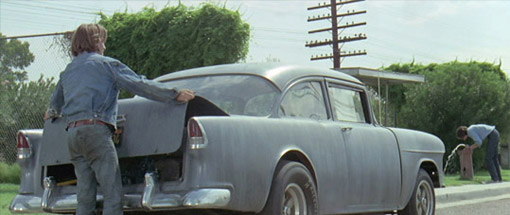
Two-Lane Blacktop is a true 'road' movie but unlike any other you've seen. It almost creates its own sub-genre of one. This isn't George Miller's feral outback in which mightily miffed Max drives the '...last of the V8 interceptors.' Nor is it the nail-bitten, nitro-fuelled Le salaire de la peur where tension can be calibrated in micro-seconds. We're in Easy Rider territory but both films are poles apart despite their apparent similarities (A Chevy for two Harleys). The road-as-life metaphor is not exactly an original idea (nor was it in 1971) but what Hellman manages with scant resources is remarkable. If the French existentialist Albert Camus (the real McCoy) hadn't himself died in a car crash in 1960, he would have adored this movie. Having seen it many times in the last month I found its power does not diminish. If anything it holds you tighter. It is, in some ways, a philosophical fly-trap and it invites you to bring your own ideas to the table. The story is pared to the bone marrow and standard movie drama is sacrificed for beautifully framed observational serendipity brought to the screen by an acting style so natural it's almost mundane – but incredibly exciting to witness. This is reality movie making without the dreadful apathy that word inspires when attached to the initials T and V. Two-Lane Blacktop is real – I can't explain why but it is – even when I know it's not. You have to love cinema, a place where paradox is alive and well.
Two American car enthusiasts (the Driver and the Mechanic) make a precarious living racing their 1955 Chevrolet (an ultra-cool car to be sure but why did it remind me so much of my father's green Ensign from the 60s?). A girl ('the Girl') tags along by climbing into their Chevy while they're at a diner. The three drift across the country and after very few words spoken (most of them are in the trailer) she beds down with the Mechanic. This movie makes Clint Eastwood's 'Man With No Name' seem positively garrulous. Just a brief aside. Both my copy of Danny Peary's excellent book Cult Movies and Wikipedia's entry on the movie describe events not in the cut of Blacktop I'm familiar with. Peary says that after a nude swim, the Girl makes love to the Driver in his own sleeping bag. Well, not in the cut I know and I have searched high and low for references to an extended cut on the internet – no luck. I know from the commentary that the first cut was more than twice as long. Could the authors of the book and article have seen an early version? Was it in the screenplay (which I've also failed to find)? There are stills in the accompanying booklet that hint at what was lost in fine cutting; the two leads shirtless and one of Taylor and Bird getting intimate up against a tree. No, not that intimate. The three aimless souls periodically encounter a driver of a GTO sport's car and a small but hugely interesting contest develops between them.
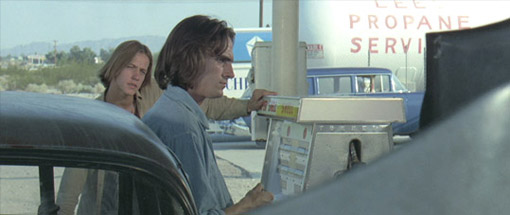
The elegiac existentialism of Monte Hellman's intimate masterpiece weaves an extraordinary spell over an open and receptive audience. I'm not just flattering you. If you're on this site, you're looking for something beyond Michael Bay (isn't everyone?) I cannot put into words the effect this film might have over you – that's the point of a movie; it's felt more than explained, a point the great Stanley Kubrick made on many occasions. How then can we use words to describe a non-literary and non-verbal experience? We can but with some heavy provisos. You'll just have to forgive the language of trying to pass on the experience of Blacktop. It's naturalistic in the sense that the characters have desires and goals but like normal human beings, motivations and actions can change in a heartbeat with no explanation. It meanders but in a dreamlike, stream-like fashion. Where we are taken is never where we expect to go but we're glad to be there all the same. It's utterly hypnotic. Just take a look at James Taylor's expression as the girl leaves their company after a kissed promise of something more than his one pedal lifestyle. He packs more subtext into that one stare of frustration-longing-sadness-acceptance than many actors of twice his range – but is that me being directed to read that into his performance? Does that, actually matter? He's living in the confines of an answer to a question he's already asked himself, exuding 'knowing' when of course answers to those profound sorts of questions (particularly at the ass end of the 60s) were ten a guru.
We have not allowed this kind of film-making to flourish in this three dimensional time of excess. Two-Lane Blacktop is a gift and all its apparent faults (seen from 2012), transform into curious virtues. To some, this could seem like half-assed storytelling but in Hellman's hands, it's as compelling a road movie I've seen. Yes, it's frustrating as a reviewer not to be able to put my finger on what makes this movie so special but that is precisely what makes it so special – work that one out. I first saw a 4x3 broadcast of Blacktop in the 80s little realising at the time that I was watching Stan Laurel without Oliver Hardy. In other words, I was missing fifty percent of Hellman's 'mise-en-scene' so I wasn't watching the movie at all. To those of you who still don't really mind what TV does to 2.35:1 movies, grab a board, cover up half the TV and see how long you can go without ripping the damn thing off the screen. 'One' Lane Blacktop simply does not work.
Hellman credits one essential aspect of his job as a director as having 90% importance. I'm sure this isn't to denigrate the actual contribution of the crew but I can see his point. He believes casting is almost all when it comes to the success of a project and based on Two-Lane Blacktop, I cannot agree more. In some ways the movie is the cast. The four principals never, ever make you feel like you're watching a movie. It's part of the dream effect (can't remember who said that cinema should be experienced as a waking dream while Michael Bay just likes to wake us up). It's also very interesting that the two leads are both musicians and not actors. James Taylor, the solo singer/song writer, plays the Driver (there are no names, just designations). His neutral expression throughout the film hardly changes but behind his eyes there's a steely acceptance of the way things are and the machinations required to keep moving one race at a time can be seen there whirring away. It's almost a Zen-like performance, nothing wasted, nothing freely given or offered at a price. It's up to the audience to figure out motivations and desires. He is the very personification of 'existentialism'. The movie's principal meanings and interpretations are all bare – there, behind his eyes.
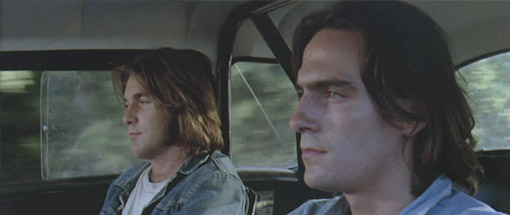
Then there's the guy banging the drums on "Wouldn't It Be Nice." A genuine Beach Boy, Dennis Wilson, Brian's younger brother, is a perfect foil to Taylor's stoic minimalism. Hellman's commentary picks out Wilson's performance a few times ("...he acts like the camera just isn't there.") This is certainly true. You could have a fine time just concentrating on Wilson and his mannerisms throughout the film. I don't know what kind of direction (if any) the two leads were given but less is significantly more. Wilson is utterly real in every scene and reacts to his fellow actors in such a convincing way, I have to keep reminding myself that this was a performance and not just what he would 'really' have done when asked or directed. Then, of course, there's 'The Girl'...
Laurie Bird was on screen in mid shot for about ten seconds in the back of the boys' Chevy before an image of a comparably young, sexy and utterly captivating actress swam into my head unbidden. Laurie Bird was the Rosanna Arquette of her generation. Arquette shined in Baby It's You in the mid 80s (even then I predicted a level of stardom; how could anyone resist casting her?) and that same look and spirit existed in Bird – innocence, wilfulness, a flower child of her time and almost oblivious to her own sex appeal. She was eighteen when she shot the movie but is no more a cipher or sexual object than any of the other cast. She's in control (despite her choice of road mates being almost haphazard) and her wayward 'going with the flow' or going with whoever's got wheels that are headed where she thinks she's headed makes her stand independently. She's wise beyond her years or is that a sleight of hand of Hellman's? Am I picking up a shadow of the 'real thing' and impressing it upon these characters? I ask again, does this matter?
The Mechanic has sex with the Girl with absolutely no lead up, no dialogue or subtext to clue you in, (OK, a shoulder rub). This was the sixties (OK, the very start of the 70s) and free love was still on the cards, a hold over from some stirrings in the 50s from Kerouac and his ilk. It's part of her make up to wear no make up and sex seems like what it is – another form of communication but in this case, it's close to arbitrary and its effect on the Driver (Taylor, who arrives late to the exterior door of hotel room) is simply to discourage him from barging in on them at the lovers' most intimate moment. Intimate implies connection but in the context of Two-Lane's universe, the sex seems more like a handshake, see how it feels, get a release and with no commitment, both are free to go anywhere afterwards; consequences do not enter into this scenario. It's (dare I say in 2012) liberating in context. Perhaps that's a male point of view but Bird's character stays free as her namesake, sex or no sex. She's also there to highlight the disconnection of the two men with the world they've chosen to turn their backs on. Whenever any of the leads are forced to communicate with outsiders (which of course is everyone else) they are aggressive or eerily acquiescent. It's an act they perform outside of their vehicle because they are only at home inside the Chevy.
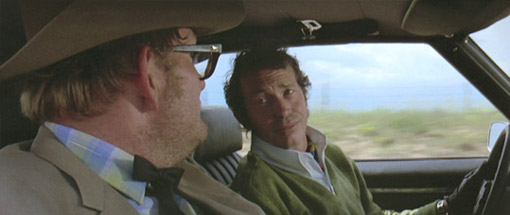
The tent pole of the cast and the only professional actor was of course the one and only Warren Oates. Whenever that rugged and continually questioning face shows itself, it's a passport to interest at the very least if not to a great movie. Talented character actors (odd phrase that – I guess it's meant to separate the mortals from the stars) are relatively rare. Let's forgive the excesses of Spielberg's 1941 and take a short stroll down Oates Lane... The Wild Bunch, In The Heat of the Night and Bring Me The Head of Alfredo Garcia. US cinema would be a lot poorer without Oates' unique contribution. In Two-Lane, he plays a man whose car is less of an extension of his manhood and more of a scaffold to which his manhood is somewhat dependent. He's a suave fantasist who spins conflicting yarns to whomever he picks up on the road and he goes from being a surface-only jerk to hidden depths which caught me out particularly when he's talking to Laurie Bird while she's asleep. If there's anything worse than being a broken fantasist, it's being a self aware broken fantasist... Oates excels as GTO and in his own curled up, foetal way, he is utterly redeemable despite his pea-cocky self-aggrandisement.
Parts of the movie have passed down the generations into independent film lore and I'm not about to give anything away to anyone tempted to give this unique work a spin. Monte Hellman is on record saying that the ending of the film came to him in a dream. I'm just pleased that there are still movies out there that have been born from a singular (in both meanings of the word) creative mind. Can you imagine a director's 'dream' getting past the suits these days? Bravo to those at Universal at the time who bankrolled Hellman and commiserations to those in the marketing department who were always going to struggle...
| |
"But it's a road movie, right? Fast cars, fast women, violence and guns?" |
| |
"It takes place on the road, yeah." |
| |
"Women?"
|
| |
"There's a girl, yeah." |
| |
"Sex?" |
| |
"Of a sort... It's more existential, a tone poem to the youth of America in the middle of the Vietnam-soured psyche of a country looking for redemption..." (losing his audience) |
| |
"And there I was looking for a tag line for the poster..." |
| |
"It has car races..." |
| |
"How about "You can never go fast enough..." |
| |
"Uh... OK." |
Please see the trailer for an egregious example of 'not getting the point' or conversely, getting the point and realizing that no one's going to get Easy Rider-rich on the back of a tone poem so screw it, let's sell it as a balls out action road race flick and see how quickly interest wanes. I'm so glad the movie hitched a ride on the cult wagon. And this Blu-ray release provides a perfect opportunity to reassess (and re-savour) a great work of cinematic art.
Considering the movie was shot in Techniscope (a very filmic term for essentially 'half' of a 35mm frame – two sprockets exposed in a strip instead of a near square four sprockets), it looks extremely good. According to the commentary, Technicolor went out of business while the movie was shot so that famous company's expensive and slow process producing dazzling to behold results livening up colours and delivering a saturated richness of image didn't grace Blacktop's original negative. According to other sources, The Godfather Part II (1974) was the last film that utilized the dye transfer process so it was still available in 1971. I suspect budgetary issues were to blame (not the wildest of guesses on my part). There are no terribly troubling focus issues (even though it's natural shape is 2.35:1, this is achieved without anamorphic lenses and therefore affording Hellman an increased depth of field). A lot of the film is shot at night and there is one car interior shot that hums with golf ball size grain but on the whole, the night scenes are wonderfully evocative and blacks are rendered almost as black as the letterboxing on my HDTV. An uncredited Gregory Sandor lit the movie while union regulations stipulated another cameraman took the official credit. He did a blinding job with so few lights. Naturalness is the watchword here and there's not a single scene where you question the light source. The detail is impressive and the transfer maintains the singular 'look' for movies made in this period, a look I am almost surgically and romantically attached to.
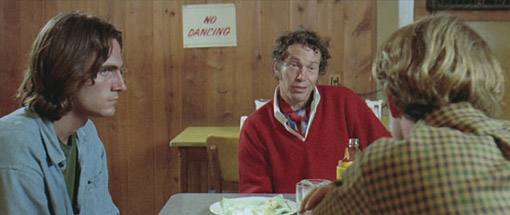
When it comes to sound... It's interesting that a film-maker can return to his/her work and if they have the requisite clout, can re-cut and 'improve' their work with modern tools. Blade Runner is probably the best example of how to do it right and anything by George Lucas (you can work out the rest of this sentence for yourself). But while picture changes inspire fandom revolts, no one seems to mind if a soundtrack is cleaned up (let's leave the Darth Vader "Nooooo!" off the whiteboard for now). Two-Lane Blackdrop has a perfectly adequate mono track but there's also a 5.1 Surround mix on offer and it's clear those that refurbished the sound are as in love with this movie as I am. It's subtle, no doubt. There aren't many car races in the film but those cars that scream past you pleasingly deliver the throaty growls to the rear speakers. That said, the sub is not given a lot to do but that could be the limitations of the source material. On the whole, both sparkling picture and rich surround sound are excellent given the age of the work. There are optional English subtitles for the deaf and hearing-impaired.
Audio Commentary by Monte Hellman and Associate Producer Gary Kurtz
It says a lot given the fractious nature of movie making that both Hellman and Associate Producer Gary Kurtz are still clearly close. It warms the cockles of the art. (I wrote that before I found out that this commentary was recorded 13 years ago. They could be at each other's throats by now...) Trivia fans note, this is a little goldmine. The first cut of this one hour, forty two minute movie was three and a half hours long – three and a half hours! The problem of patchy video distribution is cleared up quite quickly and as ever it's as mundane as 'music rights'. Hellman's contributions are frequently interspersed with the thinking word "Uuuur," and as long as some idiot like me doesn't make an issue out of it, you'll never notice. Damn. I love the fact that James Taylor was up for consideration because Hellman saw a billboard with his face on it advertising his new album.
It's here that Hellman mourns the screen tests which right away alerts you to the fact that these extras are mostly ported from elsewhere (this commentary comes from the 1999 DVD release). The screen tests were found (as most things are) in a garage and are presented as an Extra on this release. You also find out that the commentary is being performed to a VHS copy of the movie (aaah, no, say it ain't so). Hellman also emphasizes the languid editorial style rather than the fast paced cutting of (wait for it...) the 90s! And that fast paced cutting has mutated into incomprehensible chopping after twenty more years.
The one facet of the production I wanted to hear Kurtz comment on was the familiar (but green) souped-up racing car that looked oh so familiar. It was, of course, the lead's vehicle in producer Kurtz's own American Graffiti (the "piss yellow deuce coup" as Harrison Ford christened it). But Kurtz doesn't even allude to it. On the whole a little treasure trove of Blacktop behind the scenes info and a must-listen for any fan.
On The Road Again: Two-Lane Blacktop Revisited (42' 50")
This is the first of three short interview led documentaries that have all been ported from the Criterion Collection DVD of 2007. This is no bad thing as they are all excellent. Students, family (plus dog) and Hellman himself pile into a van and drive around looking for the original locations of the movie, in particular the town of Needles. There's a very interesting question from his daughter (who's the little girl in the film). She asks "Is anyone happy in Two-Lane Blacktop?" And Hellman's answer is music to my ears. "Camus says that Sisyphus** is happy..." The quote from the French writer's essay goes something like this (a translation) "The struggle itself...is enough to fill a man's heart. One must imagine Sisyphus happy."
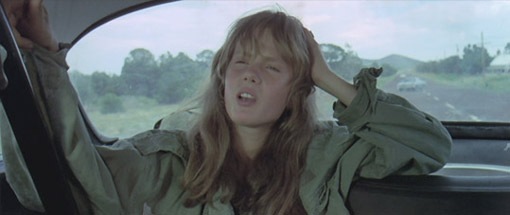
Somewhere Near Salinas (27' 39")
Hellman interviews the singer/songwriter Kris Kristofferson in two-camera coverage and it's about his vocal participation in the movie. His permission was sought for the film's use of one of his most famous songs "Me And Bobby McGee" and knowing James Taylor was the lead, he agreed unhesitatingly. These men have a history and it's interesting how both show great respect to each other's work. The conversation covers many Blacktop related topics revealing the inherent conservatism in place at Universal Studios in the early 70s. It's suggested that Blacktop is a companion piece to Pat Garret and Billy The Kid, which is as surprising as it is fascinating. Kristofferson has integrity oozing out of him but Hellman doesn't actually admit it was Janis Joplin's cover version he wanted to use in the film. No matter. It's a great conversation and a worthy addition to the Blacktop legacy.
Sure Did Talk To You (23' 23")
Directed by Hellman himself, this is an Extra featuring two separate interviews. Brooke Nasser interviews producer Michael Laughlin and Dennis Bartok (film-maker) and Steven Gaydos (ex-Variety magazine) chat with production manager Walter Coblenz, and the director's son Jared Hellman (also in the movie as the child witnessing the aftermath of the truck crash). There is some contradiction about the rain scene here (which shots were faked and which were shot during a real rain storm) but on the whole both interviews are revealing and add to the movie's status as a work criminally neglected and misunderstood at the time. There is some slight repetition in information served up but that's inevitable in a release with independent Extras. Well worth a fan's time.
Rare archival screen-test footage of James Taylor and Laurie Bird (10' 51" and 14' 50 respectivel)
And here they are (as so forlornly missed by Hellman in the 1999 commentary), the original screen tests. They have a unique and almost hard to watch fascination. I'm betting this was the first time Hellman saw James Taylor on film. What's extraordinary is that you can see the character that Hellman's after in between the awkward conversation, the self-conscious smiles and for a few seconds smattered throughout the 10 minutes, you get glimpses of this guy's interpretation of the Driver, just glimpses but were they enough to convince Hellman he was perfect for the part? Allowing him to perform a song on camera is less interesting (his singing and appeal as a vocal performer was not integral to the character of the Driver). Because of the smiling, he comes across a lot softer than his character and because of that you get an idea of just how good this guy can be (given the right director of course). What's also noteworthy is that news had just filtered through that an obscure pop group (called "The Beatles" or something like that) had just split up. Talk about ramming a tent peg into history and locking these screen tests down in time. Taylor also has the same intriguing lisp as Hugh Laurie, a few sibilants bunched up coming out almost blurred together.
Bird's screen test is also loaded with hindsight. If you know just a little about her future, what you see here is stuffed with sadness. "Best day of my whole life is going to come..." she says when asked about both her worst and best times. These were the days when she hadn't found out that her mother had not died from cancer but had committed suicide as did Bird when she was just twenty-five. As mentioned in the main review, her free-wheeling, hippy-esque manner combined with her angelic face reminded me starkly of when I first saw Rosanna Arquette in Baby, It's You. I watched Arquette's debut in the US on TV and was captivated. I would have been just as captivated if I'd seen Bird in her movie debut at the time.
Original theatrical trailer (2' 29")
Absolutely hilarious and predating the internet by decades, this unintentionally ridiculous trailer illustrates a seething desperation of a marketing division. They had something magical, light and yet powerful. So they turned it into exploitation. Using almost all the dialogue from the movie (!), Universal managed to present Blacktop as a Roger Corman movie – extraordinary. This trailer is to Blacktop as this trailer...
http://vimeo.com/32174063
...is to Jaws. Prepare your own to drop. "The far out word of the high speed scene," my arse. The words "Tone" and "Poem" simply do not set the marketing heart racing...
Optional music and effects track
Still don't get the lure of this extra feature. Perhaps I might in time. Music and Effects tracks (M&Es) are made to facilitate overseas dubbing. As presented as a stand-alone feature, I'm not sure what the attraction is. There's no soundtrack album and the most famous song from the movie is "Me And Bobby McGee", not exactly the most elusive piece of music in the world. Still, knock yourselves out.
A 36-page booklet featuring rare Production Stills
Another absolute cracker from Eureka. Despite the black hole that is digital, swallowing everything in its path, there is something akin to the icing on the cake about these booklets. I'm being slightly disingenuous here as I have only the PDF version but I have an imagination, damn it. I can imagine it in paper form. Masters Of Cinema's own Brad Stevens' final sentence in his piece captures perfectly what it's like to be sucker punched by a movie of such rare intensity and power...
"After numerous viewings, it seems to me an inexhaustible masterpiece..."
Right on. There's also Shelley Benoit's insightful essay on the new Hollywood originally published in the magazine 'Show' in March 1971 and finally as with all these booklets, notes on how to present the movie on your TV (useful if you're not that 'aspect ratio' aware as we are here on this site).
Two-Lane Blacktop is a mesmeric, intelligent and satisfyingly enigmatic tale of a sub-strata of a mighty country; three men on the road in competition and a girl who ebbs and flows between them. After early exposure to a pan and scanned version (as I mentioned, like Laurel without Hardy) I was expecting to be intrigued but not completely mesmerised. This one tiptoed up to me and managed to have me under its influence within moments and held me there - over multiple viewings. Monte Hellman's movie is a classic of its kind (that would be one of kind) and to those of you open to a very different road movie experience, this comes hugely recommended. Bravo Eureka – again!
* http://www.ejumpcut.org/archive/onlinessays/JC10-11folder/MonteHIntPasquarillo.html
** The Myth Of Sisyphus is an essay by Albert Camus that starts with the question "Does the apparent absurdity of man's life require suicide?" OK, it doesn't sound like a skip through the tulips of a read but trust me, it's a terrific thought provoker.
|